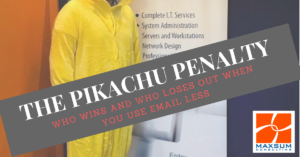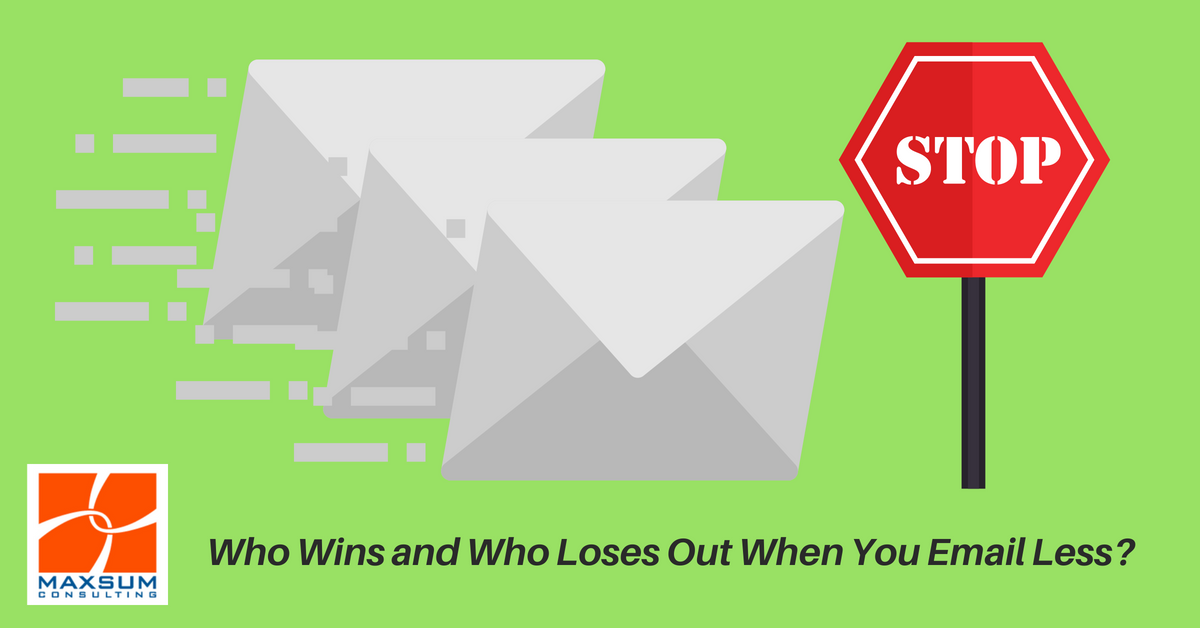[vc_row][vc_column][vc_column_text]
Who wins and who loses out when you use email less? We tried it! Find out what happened.
I don’t know how old you are, but I’m certainly of an age that I distinctly remember when I sent my first email. The thrill, the magic, and the excitement of it all! And then, believe it or not – I got a reply! Cue forward to 2018 though and email for most of us today is probably best described as a necessary evil; a convenience we all need, subconsciously resent but at the same time compulsively feel the need to check yet never get on top of.
How much email are we actually sending? (And why it’s not helping us!)
It’s not just you – it’s all of us. Statistical reports indicate that in 2018, worldwide, 281 billion emails will be sent and received EVERY DAY. The average business user receives a brain-numbing 124 emails EVERY DAY. That’s average mind you, and some of us have more – lot’s more…
Online you’ll find a plethora of articles and advice on how our email-overloaded selves are suffering. As individuals, we are constantly switched on, lack concentration, are easily distracted, less productive, less verbal and communicative face-to-face, more abrupt in writing, less willing to make conclusions without extensive consultation….and so on.
But our work productivity is suffering as well, which is bad news for our businesses. University of California research tells us that on average it takes us about 25 minutes to get back on task after an interruption to our original task. Ever stopped what you’re doing mid-task because a new email alert popped-up? Yep, we all have. And each time we do that and spend longer on the shiny new distraction, it makes it harder and harder for our human selves to get back on track.
How the Maxsum team started emailing less
Over 2016/2017 we expanded our Employee Wellness Campaign beyond fitness and health to look at a broader set of issues affecting our team’s work-life balance and “office vibe”. Not being able to keep up with the demands of their inboxes has, anecdotally, featured high on our team’s list of office bugbears. This prompted our roll-out of an “Avoid Email” campaign, with the idea being to avoid sending internal emails as much as possible and see what effect it had on productivity and office sentiment.
Here were the rules:
The Do’s:
- Actively stop yourself from sending internal emails. Ask yourself, is this a priority?
- Go FACE-TO-FACE, stop by the person’s desk or set up a meeting time.
- Respond quickly and clearly ONLY to emails that need your personal attention and input.
- FILE emails for later action if you cannot reply immediately.
- Force yourself to have an “email TURN-OFF “during non-critical times (lunch/after-hours).
The Don’ts:
- Send ANY one-word emails like “Thanks” “OK” etc. Let’s all just assume we’re super friendly and polite.
- Start an email chain for anything that requires discussion or multiple responses from various people – set up a meeting instead.
- Send any CCes, FYIs or “keeping you in the loop” emails – Make a time and update the person on multiple issues in one go if necessary.
The Penalty:
We knew this was going to be a huge challenge for our team, so we needed a pretty good deterrent! The sting involved our Operations Manager actively tracking internal email use over one month of the following the new rules. We all agreed upfront for the top offender to be named. The penalty for our most email-dependent team member would be to don a full-body Pikachu Onesie for a day of work and client meetings. And guess who lost? That’s right – yours truly! This is my good self in the Pikachu get-up. Yes I took it on the chin – just.

The Results – Did it work?
On a more serious note though, the exit survey we gave to the team at the end of the challenge was what we really wanted to see and the results showed an interesting dichotomy.
On the down sides they said using email less:
- stifled productivity,
- made it hard to get info to remote team members, and
- left some issues requiring collaborative input temporarily shelved.
But the up sides of using email less they cited were:
- cutting out the email “noise” was beneficial,
- not being cc:ed on everything made it easier to know where and when your direct action was required, and
- there was more direct communication and chat in the office.
Overall 72% of our team registered that we should continue avoiding internal email or encourage avoidance where possible, but allow internal emails to return. I think that number is pretty telling; that despite the inconveniences, being able to self-limit or “think before sending” is a beneficial exercise that does help to cut some of that noise out of the workplace.
At the end of the challenge we were a bit concerned it might be like eating chocolate cake after coming off a diet with everyone going on a big email binge. Happily though that has not been the case. This exercise did, however, provide a kind of email circuit breaker that positioned our team for adopting and using far better, more effective ways of collaborating and communicating. [Want to know what better alternatives there are to relying on email for collaboration? Click here.]
As for me – the challenge loser – lesson learnt! Although I could get quite comfy working in that onesie!
Is there an alternative to email that will actually boost communication AND productivity?
Ok – using email less sounds great you might say, but didn’t you also say it hampered productivity?
Being able to collaborate and communicate in new ways is one of the cornerstones of digital transformation. Email and our reliance on it for internal and external communication has served us well up until now, but as demands on businesses accelerate even more rapidly, email is feeling more and more like a blunt instrument. Email will always be a core component of your technology stack. But it’s time to embrace new ways of collaborating.
Get in touch with us today to talk about how you can leverage cloud solutions for collaboration, get more out of the collaboration tools baked into the Office365 suite, and explore ways to use business intelligence, data analytics and dashboarding tools to share information and insights in ways you never could over email!
Enjoyed this? You might also like to check out:
5 Office 365 Tools You’re Not Using (…But should be!) | Is Your Digital Perimeter Ready for a Mobile Workforce | 5 Questions Your “IT Dept” Needs to Ask You!
[/vc_column_text][/vc_column][/vc_row][vc_row][vc_column][vc_column_text][/vc_column_text][/vc_column][/vc_row]




